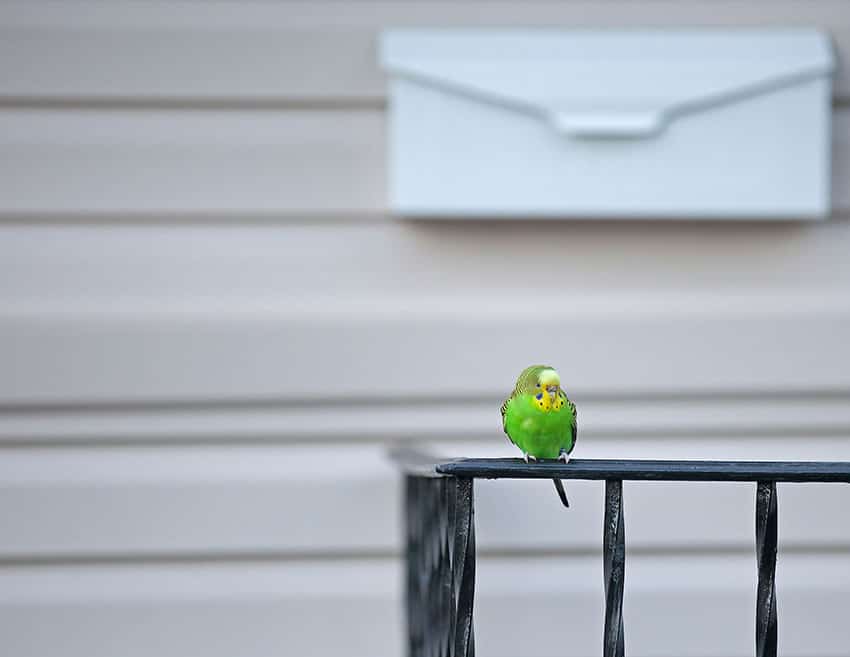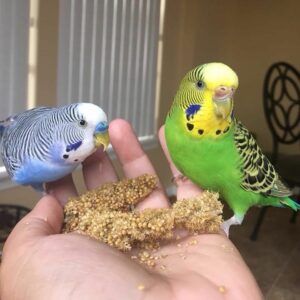If you’ve ever found yourself mesmerized by the vibrant beauty of parakeets and have been wondering how to catch one outside, you’re in the right place.
In this article, I’ll be sharing some practical tips and tricks to help you successfully catch a parakeet in an outdoor setting.
Whether you’re looking to provide a lost pet with a safe return home or simply want to experience the joy of connecting with these charming birds, I’ve got you covered.
Let’s dive into the world of parakeet catching and make your outdoor avian encounter a delightful success.

Things Required to Catch Escaped Parakeet
The parakeet capturing kit consists of a few common stuff that is available at home including a towel or a blanket, a cage, a box that can also be handy in capturing the bird, and a few small sticks which will be attached with strings.
1. Millets/Treats

You will need some treats or millets to be placed inside the cage and also outside the cage so the bird can easily see the food from high in the air
2. Water Hose
A garden hose will do the trick when you see the bird taking a flight down towards the cage you can open the water stream at low pressure and point it on the bird as it will stop the free movement of the parakeet and it will settle down on the ground
3. MP3 Player or Smart Phone with Good Speaker
An MP3 player will be a beneficial tool because you can play the chirping sounds of the birds on it the birds are very responsive to such sounds when the parakeets are free they will be nervous and search for other fellow birds, there is a good chance that they will start moving towards the sounds and you will be in with a chance to catch them when they come close.
Even a smartphone with good speakers will work.
How to Catch A Parakeet Outside?
- If the parakeet is well tamed then you can place some millets on your fingertip and start calling the bird, If case the bird is in close vicinity and has not flown far away there is a chance that it will fly to you because it will be nervous and hungry as well if some time has gone by and when it lands on your finger you can slowly bring your other hand close and capture the bird in your hand smoothly than put it back into the cage safely.
- When the parakeet is out of sight and is not tamed then you need to set up the parakeet catching kit (The above-mentioned things) where you last spotted the bird, parakeet catching kit can be made using a cage with its door open and a string attached to lock the door as soon as the bird enters the cage to eat the food or treats you have already placed inside
- If there is another cage available you can put the fellow birds in that and place it near to the empty cage. This will be a very useful trick as the escaped parakeet will be nervous and anxious it will be looking for its friends and once it spots them there is a bright chance that it will land down for them.
- In case there is only one cage you can also use a box for the purpose of catching the bird and by using a stick open the box at one end a sting can be attached and some millet/seeds/treats can be placed inside as well as outside the box and when the bird comes close to the box you can open the water in the hose but maintain the pressure of water to a minimum to avoid any damage to the little birdy water will restrict the movement of the bird and you can capture it easily with help of a towel or blanket and if it enters the box than just pull the string and there you have your cute parakeet under in the box.
- The mp3 player is a very useful tool as you can play some bird sounds on it and it is likely that the escaped parakeet will pick up the sounds and come close to it looking for fellow birds that will be your moment to grab the bird.
Once the parakeets get free outside then sometimes it can take a few days before you can actually spot them in your vicinity so you must be very patient and alert to any sign or sound of the escaped bird around you.
The worst scenario is that the parakeet finds a flock of birds upon its escape and joins them as it will never come back for sure because parakeets are naturally wild birds and they love to live in the wild.
Do Escaped Parakeet’s Comeback?
No, Once the parakeets have flown far away then there is no chance that they will come back as they will be anxious and nervous and never return to the cage or aviary but if you spot them flying in your vicinity you can call them and walk towards them by holding some millets/treats in your hand and don’t forget to carry the parakeet catching equipment with you if the luck favors you than the parakeet might respond and come towards you that will be your chance to capture your birdy.
Challenges Faced by the Parakeets Outside
Although the parakeets are naturally wild birds the pet parakeets are quite different from the wild ones in many aspects.
The pet parakeets don’t need to search the food as a variety of food is provided to them in ample quantity and it is also nutritious including seeds, fruits, and millet but when in an open environment it is very difficult for them to get this kind of food easily
The second big challenge for these small and weak birds is to avoid being attacked by predators which in their case are big birds and if the parakeets become too weak, tired, thirsty, and hungry then they will land on the ground in search of food where they can be killed and eaten up by cats or fox in the wild.
Conclusion
In conclusion, capturing a parakeet outdoors requires patience, preparation, and a gentle approach.
Remember, these colorful birds are naturally cautious, so it’s important to create an environment that fosters trust and minimizes stress.
By following the steps outlined in this article, from setting up an inviting feeding station to using the right tools and techniques, you’ll increase your chances of successfully catching a parakeet while ensuring its well-being.
Always prioritize the bird’s safety and comfort throughout the process.
Whether you’re reuniting a lost pet with its owner or simply marveling at the beauty of these creatures, your efforts contribute to the welfare of our avian friends.
With time and practice, you’ll become adept at the art of parakeet catching, forming a unique bond between human and bird.
So venture outdoors with compassion and respect, and enjoy the thrill of connecting with these wonderful beings.
As you embark on your parakeet-catching journey, remember that the journey itself is as rewarding as the destination.
Happy birding!
FAQ
Is it safe to catch a parakeet outside?
Yes, it can be safe to catch a parakeet outside if done correctly and with care. The goal is to minimize stress and avoid causing harm to the bird. Following the steps outlined in this article will help ensure the safety and well-being of the parakeet.
What tools do I need to catch a parakeet outside?
You’ll need a soft, lightweight net or cloth, a secure and comfortable carrier, and some bird-friendly food as bait. Additionally, having a pair of gloves can help protect your hands during the process.
How do I set up a feeding station to attract parakeets?
Choose a quiet and safe location outdoors. Place a tray or shallow container with fresh water and birdseed, along with some fruits like apples or berries, near the area where you’ve spotted the parakeet. Gradually move the station closer to where you’ll be attempting the capture
How do I approach a parakeet without scaring it away?
Approach the parakeet slowly and calmly. Avoid making sudden movements or loud noises. Keep a relaxed posture and allow the bird to become comfortable with your presence.
What should I do if the parakeet flies away during the capture attempt?
Stay patient. If the parakeet flies away, give it some time to settle down. Continue providing food at the feeding station to maintain its presence in the area. You can attempt the capture again once the bird is back and more at ease.
Last Updated on August 27, 2023 by Lily Aldrin
